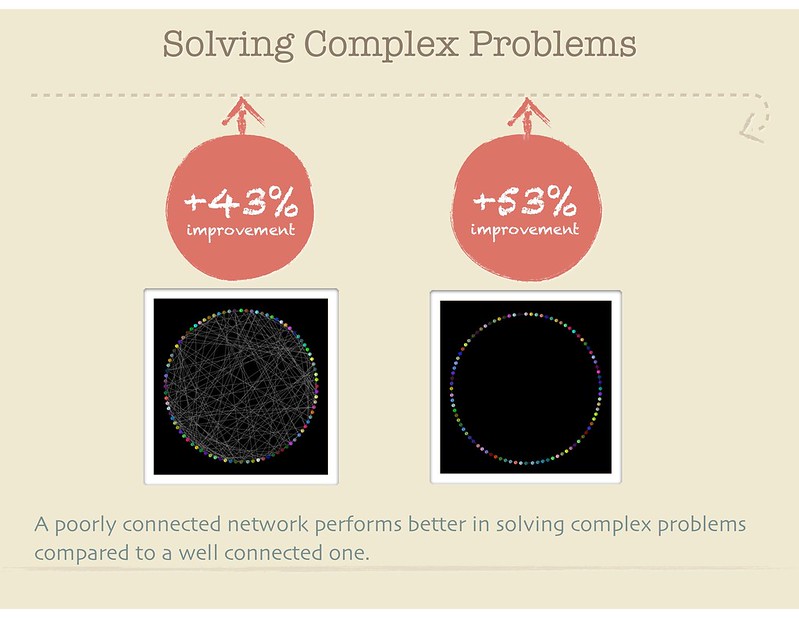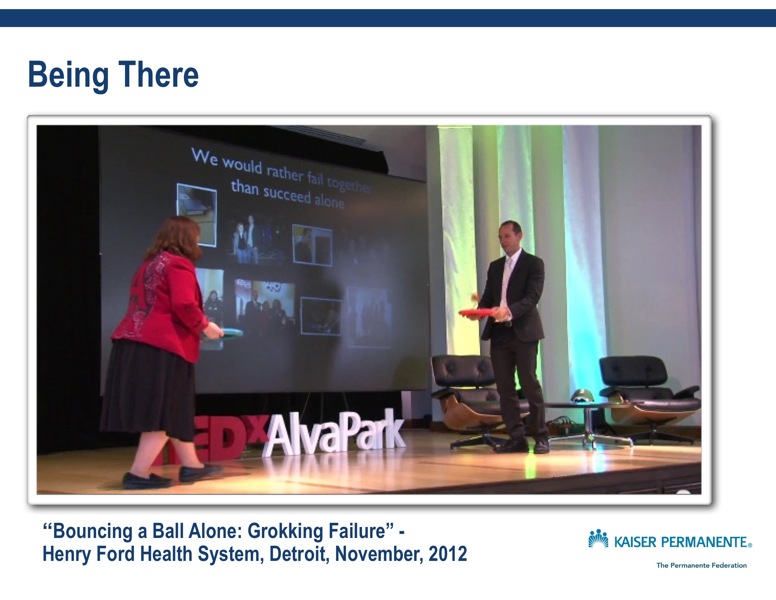This is is a less-connected network, with 88 nodes.
This is a well-connected network, 88 notes, with 172 links.
Here’s what happens when the well-connected network works to provide a solution to a complex problem.
Here’s what happens when the less-connected network does the same work, given the same amount of time.
Here’s what happens when the less connected network gets extra time.
The less connected network takes more time, but comes up with a better solution.
At the extremes (extremely un-connected, and extremely-well connected) networks do poorly.
What does this mean and how did I introduce it when talking about social media in health care recently?
- Health care can be very insular.
- People often seek solutions inside the walls and forget to connect in less-well-traveled places to learn.
- They don’t know what they don’t know.
- Using social media to talk and not listen doesn’t help this situation. That’s not being social, it’s being antisocial.
This is what it means for me.
As I mentioned in Colorado, people have connected with me online to tell me about wonderful health care experiences, as well as health care experiences that were not so wonderful, or even hurtful. Regina Holliday (@ReginaHolliday) is one amazing example. There are many others.
How do you know how to make things better if you’re only talking to people just like you?
That’s where social networks come in to help us listen and engage.
We talk about patient engagement all the time, let’s not forget physician/clinician/health professional engagement.
Today
Today is a special day in history. When people tell us to be less passionate about reducing inequality and improving health for all, the words of other misfits come to mind:
- Go ahead, have a dream.
- Don’t live someone else’s life
- The world belongs to optimists, pessimists are bystanders
Source
All computer simulations were run by me. To access the mathematical models and reference behind this example, see Lazer, David and Friedman, Allan, “The network structure of exploration and exploitation” (2007). Computer and Information Science Faculty Publications. Paper 1.





5 Comments
RT @tedeytan: Post: Less connected social networks solve complex problems better- Go ahead, have a dream http://t.co/M54Iq24FqR the @Regina…
RT @tedeytan: Post: Less connected social networks solve complex problems better- Go ahead, have a dream http://t.co/M54Iq24FqR the @Regina…
RT @tedeytan: Post: Less connected social networks solve complex problems better- Go ahead, have a dream http://t.co/M54Iq24FqR the @Regina…
Best expression of this ever: “Using social media to talk and not listen doesn’t help this situation. That’s not being social, it’s being antisocial.”
Funny, in patient events nobody needs to be told this, but when I speak at business events (including of course hospital and other healthcare businesses), it often makes eyes pop open. To those audiences, marketing and communication has always and solely been about talking at, not engaging with.
Probably no surprise, then, that the same demographic has a hard time comprehending what is means to engaged with patients clinically.
I’ve always expressed it as “The easiest way to get started in social media is to listen,” but yours is more on point. (Funny, because pharma companies I’ve worked with (for instance) approach every communication task as being so ankle-chained by regulations on what they say that it hadn’t occurred to them to just listen.
I especially like that you tie this to an opportunity to discover what we don’t know we don’t know.
Dave,
Thanks for reading, and for simplifying the world for people – rather than filling time with what we want to say, it’s never a bad idea to start with, “what’s on your mind?” and then pause….
Ted